
This composite image shows the effects of a powerful shock wave moving away from supernova 1987A. The outburst was visible to the naked eye, and is the brightest known supernova in almost 400 years. Credit: X-ray: NASA/CXC/PSU/S.Park & D.Burrows.; Optical: NASA/STScI/CfA/P.Challis
Astronomers use telescopes to scan the sky for signs of supernovae, extremely energetic explosions that occur at the end of a star's life. In order to spot a supernova with a telescope, scientists need to peer in the right direction at the right time. By using machines built for particle physics, however, scientists can scour the entire sky at once.
When supernovae explode, for about 10 seconds they release a burst of neutrinos and antineutrinos that will arrive at Earth several hours before photons, or visible light, from the explosion. Physicists have been using neutrino detectors to search for these bursts for about 20 years.
Neutrinos are among the most abundant particles in the universe, but they interact very rarely with other matter. Though trillions of naturally occurring neutrinos from the sun and other celestial bodies rain down on us each second, they can pass through the entire Earth without bumping into another particle. As we learned at the recent meeting of the Americal Physical Society, only about one in four people will be hit by a neutrino once in a lifetime. (Don't worry, you won't feel a thing.)
No matter where a neutrino detector is located on Earth, it has a chance of noticing a burst of neutrinos from elsewhere in the galaxy. Thanks to the carefree manner in which neutrinos can zip through matter, they can pass straight through the Earth and interact with a detector on the opposite side.
For decades, a network of neutrino detectors, including those located at the Gran Sasso Underground Laboratory in Italy and the Super-Kamiokande experiment in Japan, has been searching for signs of supernovae. In 1987, the Kamiokande II experiment in Japan detected a supernova originating in the Large Magellanic Cloud, a neighboring galaxy. The detector recorded signs of 11 neutrinos about three hours before telescopes saw the first visible light emitted by the burst, named Supernova 1987A.
Physicists using neutrino detectors have yet to come across any definitive signs of supernovae in our galaxy. Collaborators from the MiniBooNE neutrino experiment at Fermilab in Illinois recently reported in the journal Physical Review D that during the time period from Dec. 14, 2004, to July 31, 2008, most of the Milky Way seems to have been supernova-free.
This isn't too surprising, as astronomers predict that in our galaxy, only between one and 12 supernovae occur each century. Astronomer Johannes Kepler observed the Milky Way's last known supernova in 1604. Scientists still study the remnant of the massive explosion, called Kepler's star.
If physicists ever do catch a supernova in the act, they plan to send out an alert to observatories across the world. That way they can tell them the coordinates of a spectacular light show on its way.






